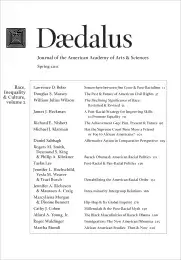Somewhere between Jim Crow & Post-Racialism
In assessing the results of the Negro revolution so far, it can be concluded that Negroes have established a foothold, no more. We have written a Declaration of Independence, itself an accomplishment, but the effort to transform the words into a life experience still lies ahead.
–Martin Luther King, Jr., Where Do We Go From Here? (1968)
By the middle of the twentieth century, the color line was as well defined and as firmly entrenched as any institution in the land. After all, it was older than most institutions, including the federal government itself. More important, it informed the content and shaped the lives of those institutions and the people who lived under them.
–John Hope Franklin, The Color Line (1993)
This is where we are right now. It’s a racial stalemate we’ve been stuck in for years. Contrary to the claims of some of my critics, black and white, I have never been so naive as to believe that we can get beyond our racial divisions in a single election cycle, or with a single candidacy – particularly a candidacy as imperfect as my own.
–Barack H. Obama, “A More Perfect Union” (May 18, 2008)1
The year 1965 marked an important inflection point in the struggle for racial justice in the United States, underscoring two fundamental points about race in America.2 First, that racial inequality and division were not only Southern problems attached to Jim Crow segregation. Second, that the nature of those inequalities and divisions was a matter not merely of formal civil status and law, but also of deeply etched economic arrangements, social and political conditions, and cultural outlooks and practices. Viewed in full, the racial divide was a challenge of truly national reach, multilayered in its complexity and depth. Therefore, the achievement of basic citizenship rights in the South was a pivotal but far from exhaustive stage of the struggle.
The positive trend of the times revolved around the achievement of voting rights. March 7, 1965, now known as Bloody Sunday, saw police and state troopers attack several hundred peaceful civil rights protestors at the Edmund Pettus Bridge in Selma, Alabama. The subsequent march from Selma to Montgomery, participated in by tens of thousands, along with other protest actions, provided the pressure that finally compelled Congress to pass the Voting Rights Act of 1965. A triumphant Reverend Martin Luther King, Jr., and other activists attended the signing in Washington, D.C., on August 6, 1965. It was a moment of great triumph for civil rights.
The long march to freedom seemed to be at its apex, inspiring talk of an era of “Second Reconstruction.” A decade earlier, in the historic Brown v. Board of Education decision of 1954, the U.S. Supreme Court repudiated the “separate but equal” doctrine. Subsequently, a major civil rights movement victory was achieved with the passage of the Civil Rights Act of 1964, which forbade discrimination in employment and in most public places. With voting rights now protected as well, and the federal government authorized to intervene directly to assure those rights, one might have expected 1965 to stand as a moment of shimmering and untarnished civil rights progress. Yet the mood of optimism and triumph did not last for long.
The negative trend of the times was epitomized by deep and explosive inequalities and resentments of race smoldering in many Northern, urban ghettos. The extent to which the “race problem” was not just a Southern problem of civil rights, but a national problem of inequality woven deep into our economic and cultural fabric, would quickly be laid bare following passage of the Voting Rights Act. Scarcely five days after then-President Johnson signed the bill into law, the Los Angeles community of Watts erupted into flames. Quelling the disorder, which raged for roughly six days, required the mobilization of the National Guard and nearly fifteen thousand troops. When disorder finally subsided, thirty-four people had died, more than one thousand had been injured, well over three thousand were arrested, and approximately $35 million in property damage had been done. Subsequent studies and reports revealed patterns of police abuse, political marginalization, intense poverty, and myriad forms of economic, housing, and social discrimination as contributing to the mix of conditions that led to the riots.
It was thus more than fitting that in 1965, Dædalus committed two issues to examining the conditions of “The Negro American.” The essays were wide-ranging. The topics addressed spanned questions of power, demographic change, economic conditions, politics and civil status, religion and the church, family and community dynamics, as well as group identity, racial attitudes, and the future of race relations. Scholars from most social scientific fields, including anthropology, economics, history, law, political science, psychology, and sociology, contributed to the volumes. No single theme or message dominated these essays. Instead, the volumes wrestled with the multidimensional and complex patterns of a rapidly changing racial terrain.
Some critical observations stand out from two of those earlier essays, which have been amplified and made centerpieces of much subsequent social science scholarship. Sociologist and anthropologist St. Clair Drake drew a distinction between what he termed primary victimization and indirect victimization. Primary victimization involved overt discrimination in the labor market that imposed a job ceiling on the economic opportunities available to blacks alongside housing discrimination and segregation that relegated blacks to racially distinct urban ghettos. Indirect or secondary victimization involved the multidimensional and cumulative disadvantages resulting from primary victimization. These consequences included poorer schooling, poor health, and greater exposure to disorder and crime. In a related vein, sociologist Daniel Patrick Moynihan stressed the central importance of employment prospects in the wake of the civil rights victories that secured the basic citizenship rights of African Americans. Both Drake and Moynihan expressed concern about a black class structure marked by signs of a large and growing economically marginalized segment of the black community. Drake went so far as to declare, “If Negroes are not to become a permanent lumpen-proletariat within American society as a result of social forces already at work and increased automation, deliberate planning by governmental and private agencies will be necessary.” Striking a similar chord, Moynihan asserted: “[T]here would also seem to be no question that opportunities for a large mass of Negro workers in the lower ranges of training and education have not been improving, that in many ways the circumstances of these workers relative to the white work force have grown worse.” This marginalized economic status, both scholars suggested, would have ramifying effects, including weakening family structures in ways likely to worsen the challenges faced by black communities.3
If the scholarly assessments of 1965 occurred against a backdrop of powerful and transformative mass-based movement for civil rights and an inchoate sense of deep but imminent change, the backdrop for most scholarly assessments today is the election of Barack Obama as president of the United States, the rise of a potent narrative of post-racialism, and a sense of stalemate or stagnation in racial change. Many meanings or interpretations can be attached to the term post-racial. In its simplest and least controversial form, the term is intended merely to signal a hopeful trajectory for events and social trends, not an accomplished fact of social life. It is something toward which we as a nation still strive and remain guardedly hopeful about fully achieving. Three other meanings of post-racialism are filled with more grounds for dispute and controversy. One of these meanings attaches to the waning salience of what some have portrayed as a “black victimology” narrative. From this perspective, black complaints and grievances about inequality and discrimination are wellworn tales, at least passé if not now pointedly false assessments of the main challenges facing blacks in a world largely free of the dismal burdens of overt racial divisions and oppression.4
A second and no less controversial view of post-racialism takes the position that the level and pace of change in the demographic makeup and the identity choices and politics of Americans are rendering the traditional black-white divide irrelevant. Accordingly, Americans increasingly revere mixture and hybridity and are rushing to embrace a decidedly “beige” view of themselves and what is good for the body politic. Old-fashioned racial dichotomies pale against the surge toward flexible, deracialized, and mixed ethnoracial identities and outlooks.5
A third, and perhaps the most controversial, view of post-racialism has the most in common with the well-rehearsed rhetoric of color blindness. To wit, American society, or at least a large and steadily growing fraction of it, has genuinely moved beyond race – so much so that we as a nation are now ready to transcend the disabling racial divisions of the past. From this perspective, nothing symbolizes better the moment of transcendence than Obama’s election as president. This transcendence is said to be especially true of a younger generation, what New Yorker editor David Remnick has referred to as “the Joshua Generation.” More than any other, this generation is ready to cross the great river of racial identity, division, and acrimony that has for so long defined American culture and politics.
It is in this context of the first African American president of the United States and the rise to prominence of the narrative of post-racialism that a group of social scientists were asked to examine, from many different disciplinary and intellectual vantage points, changes in the racial divide since the time of the Dædalus` issues focusing on race in 1965 and 1966.
The context today has points of great discontinuity and of great similarity to that mid-1960s inflection point. From the viewpoint of 1965, the election of Obama as the first African American president of the United States, as well as the expansion and the cultural prominence and success of the black middle class of which Obama is a member, speak to the enormous and enduring successes of the civil rights era. Yet also from the standpoint of 1965, the persistence of deep poverty and joblessness for a large fraction of the black population, slowly changing rates of residential segregation by race, continued evidence of antiblack discrimination in many domains of life, and historically high rates of black incarceration signal a journey toward racial justice that remains, even by superficial accounting, seriously incomplete.
In order to set a context for the essays contained in this volume, I address three key questions in this introduction. The first concerns racial boundaries. In an era of widespread talk of having achieved the post-racial society, do we have real evidence that attention to and the meaning of basic race categories are fundamentally breaking down? The second set of questions concerns the extent of economic inequality along the racial divide. Has racial economic inequality narrowed to a point where we need no longer think or talk of black disadvantage? Or have the bases of race-linked economic inequality changed so much that, at the least, the dynamics of discrimination and prejudice no longer need concern us? The third question is, how have racial attitudes changed in the period since the mid-1960s Dædalus issues?
To foreshadow a bit, I will show that basic racial boundaries are not quickly and inevitably collapsing, though they are changing and under great pressure. Racial economic inequality is less extreme today, there is a substantial black middle class, and inequality within the black population itself has probably never been greater. Yet there remain large and durable patterns of black-white economic inequality as well, patterns that are not overcome or eliminated even for the middle class and that still rest to a significant degree on discriminatory social processes. In addition, I maintain that we continue to witness the erosion and decline of Jim Crow racist attitudes in the United States. However, in their place has emerged a new pattern of attitudes and beliefs, variously labeled symbolic racism, modern racism, color-blind racism, or as I prefer it, laissez-faire racism. The new form of racism is a more covert, sophisticated, culture-centered, and subtle racist ideology, qualitatively less extreme and more socially permeable than Jim Crow racism with its attendant biological foundations and calls for overt discrimination. But this new racism yields a powerful influence in our culture and politics.6
Consider first the matter of group boundaries. The 2000 Census broke new ground by allowing individuals to mark more than one box in designating racial background. Indeed, great political pressure and tumult led to the decision to move the Census in a direction that more formally and institutionally acknowledged the presence of increasing mixture and heterogeneity in the American population with regard to racial background. Nearly seven million people exercised that option in 2000. The successful rise of Obama to the office of president, the first African American to do so, as a child of a white American mother and a black Kenyan father, has only accelerated the sense of the newfound latitude and recognition granted to those who claim more than one racial heritage.7
Despite Obama’s electoral success and the press attention given to the phenomenon, some will no doubt find it surprising that the overwhelming majority of Americans identify with only one race. As Figure 1 shows, less than 2 percent of the population marked more than one box on the 2000 Census in designating their racial background. Fully 98 percent marked just one. I claim no deep-rootedness or profound personal salience for these identities. Rather, my point is that we should be mindful that the level of “discussion” and contention around mixture is far out of proportion to the extent to which most Americans actually designate and see themselves in these terms. Moreover, even if we restrict attention to just those who marked more than one box, two-thirds of these respondents designated two groups other than blacks (namely, Hispanic-white, Asian-white, or Hispanic and Asian mixtures), as Figure 2 shows. Some degree of mixture with black constituted just under a third of mixed race identifiers in 2000. Given the historic size of the black population and the extended length of contact with white Americans, this remarkable result says something powerful about the potency and durability of the historic black-white divide.
It is worth recalling that sexual relations and childbearing across the racial divide are not recent phenomena. The 1890 U.S. Census contained categories for not only “Negro” but also “Mulatto,” “Quadroon,” and even “Octoroon”; these were clear signs of the extent of “mixing” that had taken place in the United States. Indeed, well over one million individuals fell into one of the mixed race categories at that time. In order to protect the institution of slavery and to prevent the offspring of white slave masters and exploited black slave women from having a claim on freedom as well as on the property of the master, slave status, as defined by law, followed the mother’s status, not the father’s. For most of its history, the United States legally barred or discouraged racial mixing and intermarriage. At the time of the Loving v. Virginia case in 1967, seventeen states still banned racial intermarriage. 8
Figure 1
Percent of Respondents to U.S. Census 2000 Identifying with One Race or Two or More Races (Non-Hispanic)
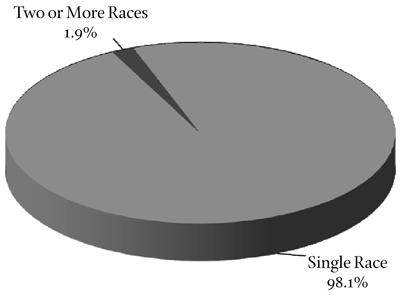
Source: Author’s analysis of data from U.S. Census Bureau, Census 2000 Redistricting (Public Law 94-171) Summary File, 2001, Table PL1.
Figure 2
Percent of Respondents to U.S. Census 2000 Identifying with Two or More Races Who Chose Black in Combination with One or More Other Races (Non-Hispanic)
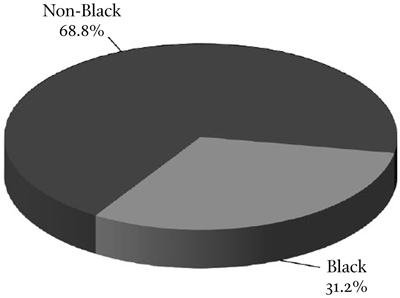
Source: Author’s analysis of data from U.S. Census Bureau, Census 2000 Summary File 1, 2001, Matrices P8 and P10.
Formal, legal definitions of who was black, and especially the development of rules of “hypodescent,” or the one-drop rule, have a further implication that is often lost in discussions of race: these practices tended to fuse together race and class, in effect making blackness synonymous with the very bottom of the class structure. As historian David Hollinger explains:
The combination of hypodescent with the denial to blacks residing in many states with large black populations of any opportunity for legal marriage to whites ensured that the color line would long remain to a very large extent a property line. Hence the dynamics of race formation and the dynamics of class formation were, in this most crucial of all American cases, largely the same. This is one of the most important truths about the history of the United States brought into sharper focus when that history is viewed through the lens of the question of ethnoracial mixture.9
Still, we know that today the ethnoracial landscape in the United States is changing. As of the 2000 Census, whites constituted just 69 percent of the U.S. population, with Hispanics and blacks each around 12 percent. This distribution represents a substantial decline in the percentage of whites from twenty or, even more so, forty years ago.
With continued immigration, differential group fertility patterns, and the continued degree of intermarriage and mixing, these patterns will not remain stable. Figure 3 shows the Census racial distribution projections out to the year 2050. The figure clearly shows a continued steady and rapid decline in the relative size of the white population; forecasts predict that somewhere between 2040 and 2045, whites will cease to be a numerical majority of the population. (This change could possibly happen much sooner than that.) The relative size of the Hispanic population is expected to grow substantially, with the black, Asian, Native Hawaiian and other Pacific Islander, American Indian, and Alaska Native groups remaining relatively constant. Figure 3 strongly implies that pressure to transform our understanding of racial categories will continue.
Does that pressure for change foretell the ultimate undoing of the black-white divide? At least three lines of research raise doubts about such a forecast. First, studies of the perceptions of and identities among those of mixed racial backgrounds point to strong evidence of the cultural persistence of the one-drop rule. Systematic experiments by sociologists and social psychologists are intriguing in this regard. For example, sociologist Melissa Herman’s recent research concluded that “others’ perceptions shape a person’s identity and social understandings of race. My study found that partblack multiracial youth are more likely to be seen as black by observers and to define themselves as black when forced to choose one race.”10
Second, studies of patterns in racial intermarriage point to a highly durable if somewhat less extreme black-white divide today. A careful assessment of racial intermarriage patterns in 1990 by demographer Vincent Kang Fu found that “one key feature of the data is overwhelming endogamy for blacks and whites. At least 92 percent of white men, white women, black women and black men are married to members of their own group.”11 Rates of intermarriage rose for blacks and whites over the course of the 1990s. However, subsequent analysts continued to stress the degree to which a fundamental black-white divide persists. As demographers Zhenchao Qian and Daniel Lichter conclude in their analyses of U.S. Census data from 1990 and 2000:
[O]ur results also highlight a singularly persistent substantive lesson: African Americans are least likely of all racial/ ethnic minorities to marry whites. And, although the pace of marital assimilation among African Americans proceeded more rapidly over the 1990s than it did in earlier decades, the social boundaries between African American and whites remain highly rigid and resilient to change. The “one-drop” rule apparently persists for African Americans.12
Figure 3
Population Projections by Race and Ethnicity, 2000 to 2050
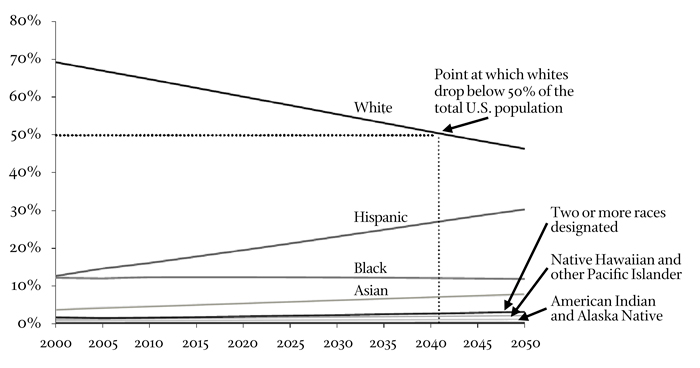
Source: Author’s analysis of data on race from Population Division, U.S. Census Bureau, Projected Population by Single Year of Age, Sex, Race, and Hispanic Origin for the United States: July 1, 2000 to July 1, 2050 (August 14, 2008).
Third, some key synthetic works argue for an evolving racial scheme in the United States, but a scheme that nonetheless preserves a heavily stigmatized black category. A decade ago, sociologist Herbert Gans offered the provocative but well-grounded speculation that the United States would witness a transition from a society defined by a great white–non-white divide to one increasingly defined by a black–non-black fissure, with an in-between or residual category for those granted provisional or “honorary white” status. As Gans explained: “If current trends persist, today’s multiracial hierarchy could be replaced by what I think of as a dual or bimodal one consisting of ‘nonblack’ and ‘black’ population categories, with a third ‘residual’ category for the groups that do not, or do not yet, fit into the basic dualism.” Most troubling, this new dualism would, in Gans’s expectations, continue to bring a profound sense of undeservingness and stigma for those assigned its bottom rung.13
Gans’s remarks have recently received substantial support from demographer Frank Bean and his colleagues. Based on their extensive analyses of population trends across a variety of indicators, Bean and colleagues write: “A black-nonblack divide appears to be taking shape in the United States, in which Asians and Latinos are closer to whites. Hence, America’s color lines are moving toward a new demarcation that places many blacks in a position of disadvantage similar to that resulting from the traditional black-white divide.”
If basic racial categories and identities are not soon to dissolve, then let me now address that second set of questions, concerning the degree of racial economic inequality. I should begin by noting that there has been considerable expansion in the size, security, and, arguably, salience and influence of the black middle class.14
Turning to the question of income, we find a similar trend. Figure 4 reports on the distribution of the population by race since 1968 across several ways of slicing the family income distribution. At the very bottom are those who the Census would designate as the “very poor”: that is, having a family income that is 50 percent or less of the poverty level. At the very top are those in the “comfortable” category, having family incomes that are five times or more the poverty level. The proportion of whites in this upper category exceeded 10 percent in 1960 and rose to nearly 30 percent by 2008. For blacks, the proportion was less than 5 percent in 1968 but about 12 percent in 2008. Likewise, the fraction in the middle class (those with family incomes more than twice the poverty level) grows for both groups. But crucially, the proportion of blacks in the “poor” (at the poverty line) or “very poor” categories remains large, at a combined figure of nearly 40 percent in 2008. This contrasts with the roughly 20 percent of whites in those same categories.15
The official black poverty rate has fluctuated between two to three times the poverty rate for whites. Recent trend analyses suggest that this disparity declined during the economic boom years of the 1990s but remained substantial. As public policy analyst Michael Stoll explains: “Among all black families, the poverty rate declined from a 20 year high of about 40 percent in 1982 and 1993 to 25 percent in 2000. During this period, the poverty rate for white families remained fairly constant, at about 10 percent.” That figure of 25 percent remains true through more recent estimates. In addition, the Great Recession has taken a particularly heavy toll on minority communities, African Americans perhaps most of all. As the Center for American Progress declared in a recent report: “Economic security and losses during the recession and recovery exacerbated the already weak situation for African Americans. They experienced declining employment rates, rising poverty rates, falling home-ownership rates, decreasing health insurance and retirement coverage during the last business cycle from 2001 to 2007. The recession that followed made a bad situation much worse.”16
Overall trends in poverty, however, do not fully capture the cumulative and multidimensional nature of black economic disadvantage. Sociologist William Julius Wilson stresses how circumstances of persistently weak employment prospects and joblessness, particularly for low-skilled black men, weaken the formation of stable two-parent households and undermine other community structures. Persistent economic hardship and weakened social institutions then create circumstances that lead to rising rates of single-parent households, out-of-wedlock childbearing, welfare dependency, and greater risk of juvenile delinquency and involvement in crime. Harvard sociologist Robert Sampson points to an extraordinary circumstance of exposure to living in deeply disadvantaged communities for large segments of the African American population. This disadvantage involves living in conditions that expose residents to high surrounding rates of unemployment, family breakup, individuals and families reliant on welfare, poor-performing schools, juvenile delinquency, and crime. As Sampson explains:
[A]lthough we knew that the average national rate of family disruption and poverty among blacks was two to four times higher than among whites, the number of distinct ecological contexts in which blacks achieve equality to whites is striking. In not one city of 100,000 or more in the United States do blacks live in ecological equality with whites when it comes to these basic features of economic and family organization. Accordingly, racial differences in poverty and family disruption are so strong that the “worst” urban contexts in which whites reside are considerably better than the average context of black communities.17
Figure 4
Economic Status of the Black and White Population, 1968 to 2008
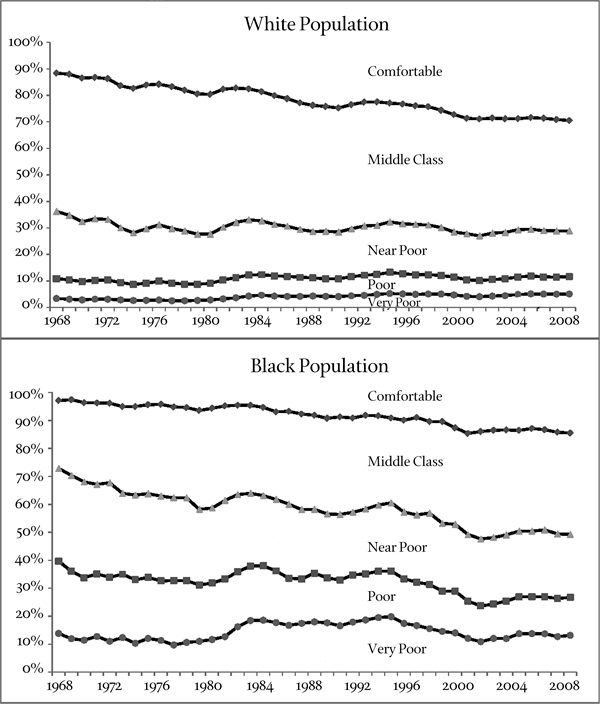
Very poor denotes below 50 percent of the poverty line; poor, 50 to 90 percent of the poverty line; near poor, 100 to 199 percent of the poverty line; middle class, 200 to 499 percent of the poverty line; and comfortable, 500 percent of poverty line. Source: Author’s analysis of data from Miriam King, Steven Ruggles, Trent Alexander, Donna Leicach, and Matthew Sobek, Integrated Public Use Microdata Series, Current Population Survey: Version 2.0 (Minneapolis: Minnesota Population Center, 2008).
Recent work published by sociologist Patrick Sharkey assesses race differences in the chances of mobility out of impoverished neighborhoods. The result is a very depressing one. He finds evidence of little upward social mobility for disadvantaged blacks and a fragile capacity to maintain advantaged status among even the most well-off African Americans. He writes: “[M]ore than 70% of black children who are raised in the poorest quarter of American neighborhoods will continue to live in the poorest quarter of neighborhoods as adults. Since the 1970s, more than half of black families have lived in the poorest quarter of neighborhoods in consecutive generations, compared to just 7% of white families.” Discussing the upper end, Sharkey writes: “Among the small number of black families who live in the top quartile, only 35% remain there in the second generation. By themselves, these figures reveal the striking persistence of neighborhood disadvantage among black families.” This figure of 35 percent remaining in the top quartile across generations for blacks contrasts to 63 percent among whites. Thus, “White families exhibit a high rate of mobility out of the poorest neighborhoods and a low rate of mobility out of the most affluent neighborhoods, and the opposite is true among black families.”18
The general labor market prospects of African Americans have undergone key changes in the last several decades. Three patterns loom large. There is far more internal differentiation and inequality within the black population than was true at the close of World War II, or even during our baseline of the mid-1960s. The fortunes of men and women have recently diverged within the black community. Black women have considerably narrowed the gap between themselves and white women in terms of educational attainment, major occupational categories, and earnings. Black men have faced a growing problem of economic marginalization. Importantly, this is contingent on levels of education; education has become a far sharper dividing line, shaping life chances more heavily than ever before in the black community.19
Several other dimensions of socioeconomic status bear mentioning. Even by conservative estimates, the high school dropout rate among blacks is twice that of whites, at 20 percent versus 11 percent. Blacks also have much lower college completion rates (17 percent versus 30 percent) and lower advanced degree completion rates (6 percent versus 11 percent). These differences are enormously consequential. As the essays in this volume by economist James Heckman and social psychologist Richard Nisbett emphasize, educational attainment and achievement increasingly define access to the good life, broadly defined. Moreover, some scholars make a strong case that important inequalities in resources still plague the educational experiences of many black school children, involving such factors as fewer well-trained teachers and less access to ap courses and other curriculum-enriching materials and experiences.20
One of the major social trends affecting African Americans over the past several decades has been the sharply punitive and incarceration-focused turn in the American criminal justice system. Between 1980 and 2000, the rate of black incarceration nearly tripled. The black-to-white incarceration ratio increased to above eight to one during this time period. Actuarial forecasts, or lifetime estimates, of the risk of incarceration for black males born in the 1990s approach one in three, as compared to below one in ten for non-Hispanic white males. A recent major study by the Pew Foundation reported that as of 2007, one in fifteen black males age eighteen and above was in jail or prison, and one in nine black males between the ages of twenty and thirty-four was in jail or prison. Blacks constitute a hugely disproportionate share of those incarcerated relative to their numbers in the general population.21
The reach of mass incarceration has risen to such levels that some analysts view it as altering normative life-course experiences for blacks in low-income neighborhoods. Indeed, the fabric of social life changes in heavily policed, low-income urban communities. The degree of incarceration has prompted scholars to describe the change as ushering in a new fourth stage of racial oppression, “the carceral state,” constituted by the emergence of “the new Jim Crow” or, more narrowly, racialized mass incarceration. Whichever label one employs, there is no denying that exposure to the criminal justice system touches the lives of a large fraction of the African American population, especially young men of low education and skill levels. These low levels of education and greater exposure to poverty, along with what many regard as the racially biased conduct of the War on Drugs, play a huge role in black overrepresentation in jails or federal and state prisons.22
Processes of racial residential segregation are a key factor in contemporary racial inequality. Despite important declines in overall rates of segregation over the past three decades and blacks’ increasing suburbanization, blacks remain highly segregated from whites. Some have suggested that active self-segregation on the part of blacks is now a major factor sustaining residential segregation. A number of careful investigations of preferences for neighborhood characteristics and makeup and of the housing search process strongly challenge such claims. Instead, there is substantial evidence that, particularly among white Americans, neighborhoods and social spaces are strongly racially coded, with negative racial stereotypes playing a powerful role in shaping the degree of willingness to enter (or remain) in racially integrated living spaces. Moreover, careful auditing studies continue to show lower, but still significant, rates of antiblack discrimination on the part of real estate agents, homeowners, and landlords.23
Lastly, I want to stress that wealth inequality between blacks and whites remains enormous. Recent scholarship has convincingly argued that wealth (or accumulated assets) is a crucial determinant of quality of life. Blacks at all levels of the class hierarchy typically possess far less wealth than otherwise comparable whites. Moreover, the composition of black wealth is more heavily based in homes and automobiles as compared to white wealth, which includes a more even spread across savings, stocks and bonds, business ownership, and other more readily liquidated assets. Whereas approximately 75 percent of whites own their homes, only 47 percent of blacks do. Looking beyond home-ownership to the full range of financial assets, analyses from sociologists Melvin Oliver and Tom Shapiro put the black-to-white wealth gap ratio in the range of ten or eleven to one. Other estimates, such as those based on Panel Study of Income Dynamics data, are lower but still represent gaping disparities.24
In order to provide a more concrete picture of the current state of the wealth gap, Figure 5 reproduces results from a recent Brandeis University study. It shows that over the past twenty-three years, the black-white gap in median wealth rose dramatically, moving from $20,000 in 1984 to nearly $100,000 by 2007. The study also revealed that for much of this time period, middle-income white families had more wealth than even the highest income segment of African American families, with that gap rising to $56,000 by 2007. Moreover, all earners, but especially African Americans, have fallen far behind the high-income white families in median wealth holdings. To the extent that wealth bears on the capacity to survive a period of unemployment, to finance college for one’s children, or to endure a costly illness or other unexpected large expense, these figures point to an enormous and growing disparity in the life chances of blacks and whites in the United States.25
Figure 5
Median Wealth Holdings of White Families and African American Families, 1984 to 2007
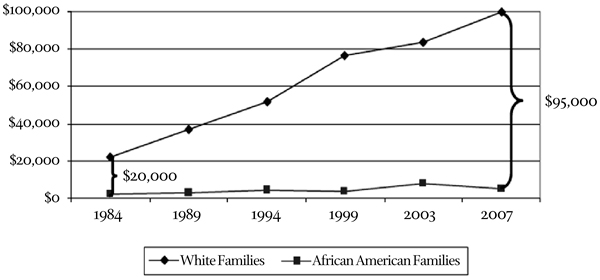
Data do not include home equity. Source: Thomas Shapiro, Tatjana Meschede, and Laura Sullivan, “The Racial Wealth Gap Increases Fourfold,” Research and Policy Brief, Institute on Assets and Social Policy, Heller School for Social Policy and Management, Brandeis University, May 2010.
In many respects, these sizable gaps in wealth associated with race are one of the principal ways in which the cumulative and “sedimentary” impact of a long history of racial oppression manifests itself. Research has shown that black and white families do not differ substantially in the extent to which they try to save income. Much wealth is inherited; it is not the product of strictly individual merit or achievement. Furthermore, social policy in many ways played a direct role in facilitating the accumulation of wealth for many generations of white Americans while systematically constraining or undermining such opportunities for African Americans. For example, Oliver and Shapiro and political scientist Ira Katznelson both point to federal home mortgage lending guidelines and practices, which were once openly discriminatory, as playing a crucial role in this process.26
What do we know about changes in racial attitudes in the United States? The first and most consistent finding of the major national studies of racial attitudes in the United States has been a steady repudiation of the outlooks that supported the Jim Crow social order. Jim Crow racism once reigned in American society, particularly in the South. Accordingly, blacks were understood as inherently inferior to whites, both intellectually and temperamentally. As a result, society was to be expressly ordered in terms of white privilege, with blacks relegated to secondary status in education, access to jobs, and in civic status such as the right to vote. Above all, racial mixture was to be avoided; hence, society needed to be segregated. The best survey data on American public opinion suggest that this set of ideas has been in steady retreat since the 1940s.27
Figure 6 contains one telling illustration of this trend. It shows the percentage of white Americans in national surveys who said that they would not be willing to vote for a qualified black candidate for president if nominated by their own party. When first asked in 1958, nearly two out of three white Americans endorsed such an openly discriminatory posture. That trend has undergone unabated decline, reaching the point where roughly only one in five white Americans expressed this view by the time the Reverend Jesse Jackson launched his first bid for the Democratic presidential nomination in 1984. It declined to fewer than one in ten by the time of Obama’s campaign in 2008.
In broad sweep, though not necessarily in exact levels, the trend seen in Figure 6 is true of most questions on racial attitudes from national surveys that deal with broad principles of whether American society should be integrated or segregated, discriminatory or nondiscriminatory on the basis of race. Whether the specific domain involved school integration, residential integration, or even racial intermarriage, the level of endorsement of discriminatory, segregationist responses has continued to decline. To an important degree, these changes have been led by highly educated whites and those outside the South. African Americans have never endorsed elements of the Jim Crow outlook to any substantial degree, though many of these questions were not initially asked of black respondents out of fear that the questions would be regarded as an insult, or to the assumption that their responses were predictable.
Figure 6
Percent of Whites Who Said They Would Not Vote for a Black Presidential Candidate, 1958 to 2008
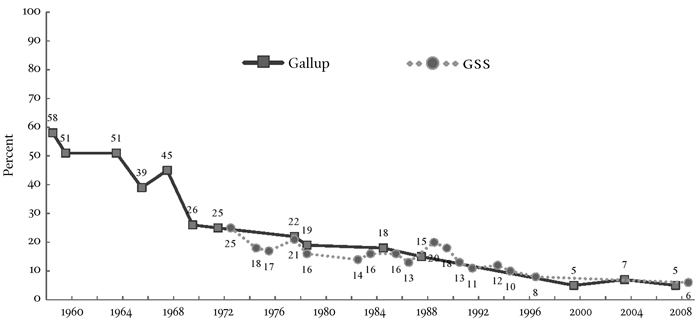
The Gallup Poll asked, “If your party nominated a generally well-qualified person for president who happened to be black, would you vote for that person?” The General Social Survey (GSS) asked, “If your party nominated a (negro/black/African-American) for President, would you vote for him if he were qualified for the job?” Source: Author’s analysis of data from Gallup Poll, 1958–2007; Jeffrey M. Jones, “Some Americans Reluctant to Vote for Mormon, 72-Year-Old Presidential Candidates,” in The Gallup Poll: Public Opinion 2007, ed. George Horace Gallup (Lanham, Md.: Rowman and Littlefield, 2008), 77–78; author’s analysis of data from GSS Cumulative Data File, 1972–2008.
This picture of the repudiation of Jim Crow is complicated somewhat by evidence of significant social distance preferences. To be sure, low and typically declining percentages of whites objected when asked about entering into integrated social settings – neighborhoods or schools – where one or just a small number of blacks might be present. But as the number of blacks involved increased, and as one shifts from more impersonal and public domains of life (workplaces, schools, neighborhoods) to more intimate and personal domains (intermarriage), expressed levels of white resistance rise and the degree of positive change is not as great.
The notion of the 1960s as an inflection point in the struggle for racial change is reinforced by the growing preoccupation of studies of racial attitudes in the post-1960 period with matters of public policy. These studies consider levels of support or opposition to public policies designed to bring about greater racial equality (antidiscrimination laws and various forms of affirmative action) and actual integration (open housing laws and methods of school desegregation such as school busing). The picture that results is complex but has several recurrent features. Blacks are typically far more supportive of social-policy intervention on matters of race than are whites. In general, support for policy or governmental intervention to bring about greater integration or to reduce racial inequality lags well behind endorsement of similar broad principles or ideals. This finding has led many scholars to note a “principle-implementation gap.” Some policies, however, have wider appeal than others. Efforts to enhance or improve the human capital attributes of blacks and other minority group members are more popular than policies that call for group preferences. Forms of affirmative action that imply quotas or otherwise disregard meritocratic criteria of reward are deeply unpopular.
One important line of investigation seeking to understand the principle implementation gap involved assessments of perceptions and causal attributions for racial inequality. To the extent that many individuals do not perceive much racial inequality, or explain it in terms of individual dispositions and choices (as opposed to structural constraints and conditions such as discrimination), then there is little need seen for government action. Table 1 shows responses to a series of questions on possible causes of black-white economic inequality that included “less inborn ability,” “lack of motivation and willpower,” “no chance for an education,” and “mainly due to discrimination.” The questions thus span biological basis (ability), cultural basis (motivation), a weak form of structural constraint (education), and finally, a strong structural constraint (discrimination).28
There is low and decreasing support among whites for the overtly racist belief that blacks have less inborn ability. The most widely endorsed account among whites points to a lack of motivation or willpower on the part of blacks as a key factor in racial inequality, though this attribution declines over time. Attributions to discrimination as well as to the weaker structural account of lack of a chance for education also decline among whites. Blacks are generally far more likely than whites to endorse structural accounts of racial inequality, particularly the strongest attribution of discrimination. However, like their white counterparts, a declining number of blacks point to discrimination as the key factor, and there is actually a rise in the percentage of African Americans attributing racial inequality to a lack of motivation or willpower on the part of blacks themselves. More detailed multivariate analyses suggest that there has been growth in cultural attributions for racial inequality. Among African Americans this growth seems most prominent among somewhat younger, ideologically conservative, and less well-educated individuals.29
Table 1
Explanations for Racial Socioeconomic Inequality by Education and Age across Selected Years
| Whites | ||||||||
| Inequality is Due to: | Pooled | Years of Education | Age | |||||
| 12 | <12 | 13+ | 18-33 | 34-50 | 51+ | |||
| Discrimination Less Inborn Ability Lack of Chance for Education Lack of Motivation or Willpower |
1977-1989 1990-1999 2000-2008 1977-1989 1990-1999 2000-2008 1977-1989 1990-1999 2000-2008 1977-1989 1990-1999 2000-2008 |
40% 35 30 21 13 9 52 47 43 63 55 50 |
40 47 30 36 27 20 42 37 33 74 70 66 |
37 32 27 22 16 13 48 41 36 67 63 61 |
43 36 32 11 6 5 63 55 49 51 46 41 |
46 35 31 12 7 6 55 46 41 54 50 45 |
39 34 28 16 8 7 52 49 45 62 50 45 |
36 35 32 35 22 13 49 47 44 72 65 57 |
| Blacks | ||||||||
| Inequality is Due to: | Pooled | Years of Education | Age | |||||
| 12 | <12 | 13+ | 18-33 | 34-50 | 51+ | |||
| Discrimination Less Inborn Ability Lack of Chance for Education Lack of Motivation or Willpower |
1977-1989 1990-1999 2000-2008 1977-1989 1990-1999 2000-2008 1977-1989 1990-1999 2000-2008 1977-1989 1990-1999 2000-2008 |
77% 71 59 16 11 13 68 60 52 35 38 44 |
82 74 62 31 16 23 69 63 56 44 43 51 |
72 68 54 9 12 13 65 61 46 34 40 50 |
76 73 62 4 6 8 70 57 55 26 33 38 |
75 67 52 8 10 11 63 55 47 30 45 49 |
79 74 58 12 8 11 68 55 50 33 32 42 |
79 72 69 26 15 17 75 72 61 44 38 42 |
Respondents were asked, “On the average (Negroes/Blacks/African-Americans) have worse jobs, income, and housing than white people. Do you think these differences are”: “mainly due to discrimination”; “because most (Negroes/Blacks/African-Americans) have less inborn ability to learn”; “because most (Negroes/Blacks/African-Americans) don’t have the chance for education that it takes to rise out of poverty”; or “because most (Negroes/Blacks/African-Americans) just don’t have the motivation or willpower to pull themselves up out of poverty?” N for whites ranges between 5,307 and 16,906. N for blacks ranges between 517 and 2,387. Source: Author’s analysis of data from General Social Survey, 1977–2008.
Another line of analysis of racial attitudes sparked in part by the principle implementation gap involved renewed interest in the extent of negative racial stereotyping. Figure 7 shows trends in whites’ stereotype trait ratings of whites as compared to blacks on the dimensions of being hardworking or lazy and intelligent or unintelligent. In 1990, when these trait-rating stereotype questions were first posed in national surveys, more than 60 percent of whites rated whites as more likely to be hardworking than blacks, and just under 60 percent rated blacks as less intelligent. A variety of other trait dimensions were included in this early assessment, such as welfare dependency, involvement in drugs and gangs, and levels of patriotism. Whites usually expressed a substantially negative image of blacks relative to how they rated whites across this array of traits. The trends suggest some slight reduction in negative stereotyping over the past two decades, but such negative images of blacks still remain quite commonplace. To the extent that unfavorable beliefs about the behavioral characteristics of blacks have a bearing on levels of support for policies designed to benefit blacks, these data imply, and much evidence confirms, that negative beliefs about blacks’ abilities and behavioral choices contribute to low levels of white support for significant social policy interventions to ameliorate racial inequality.30
Figure 7
Percent of Respondents Who Said Whites Are More Hardworking or More Intelligent than Blacks, 1990 to 2008
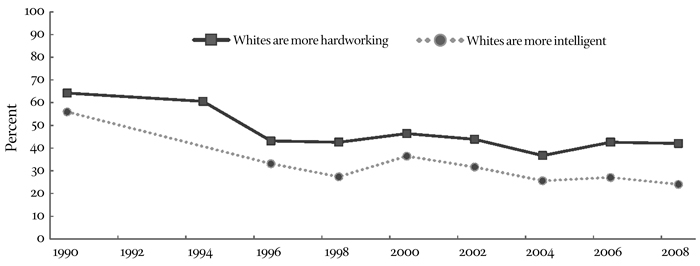
White respondents were asked to rate blacks and whites according to whether they thought blacks and whites tended to be hardworking or lazy. Respondents were also asked, “Do people in these groups tend to be unintelligent or tend to be intelligent? Where would you rate whites in general on this scale? Blacks?” The comparison is generated by subtracting the scores whites are given on a one to seven point scale from the scores blacks are given on each measure. On the resulting scale, positive numbers indicate that blacks are rated as possessing more of the desirable trait than whites; negative scores indicate that whites are rated more positively; and scores of zero indicate that both groups received equal ratings. Negative scores were coded as agreeing. Seven percent of whites rated blacks as more hardworking than whites, and 6 percent rated blacks as more intelligent. Source: Author’s analysis of data from General Social Survey, 1990–2008.
A third and perhaps most vigorously considered resolution of the principle implementation gap involves the hypothesis that a new form of antiblack racism is at the root of much white opposition to policies aimed at reducing racial inequality. This scholarship has focused largely on the emergence of attitudes of resentment toward the demands or grievances voiced by African Americans and the expectation of governmental redress for those demands and grievances. Figure 8 shows trends for one question frequently used to tap such sentiments; respondents are asked to agree or disagree with the statement, “Irish, Italian, Jewish and many other minorities overcame prejudice and worked their way up. Blacks should do the same without special favors.” Throughout the 1994 to 2008 time span, roughly three-fourths of white Americans agreed with this assertion. The figure shows no meaningful trend, despite a slight dip in 2004: the lopsided view among whites is that blacks need to make it all on their own.31
Figure 8
Percent of Respondents Agreeing with the Belief that Blacks Should Overcome Prejudice without Special Favors, 1994 to 2008
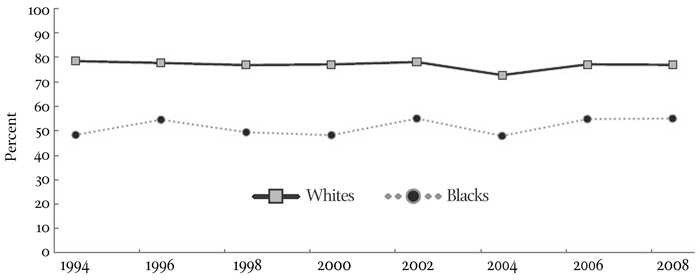
Respondents were asked, “Do you agree strongly, agree somewhat, neither agree nor disagree, disagree somewhat, or disagree strongly with the following statement: Irish, Italian, Jewish and many other minorities overcame prejudice and worked their way up. Blacks should do the same without special favors.” “Agree strongly” and “agree somewhat” responses are coded as agreeing. Source: Author’s analysis of data from General Social Survey, 1994–2008.
Throughout the fourteen-year time span, whites were always substantially more likely to endorse this viewpoint than blacks; however, not only did a nontrivial number of blacks agree with it (about 50 percent), but the black-white gap actually narrowed slightly over time. The meaning and effects of this type of outlook vary in important ways depending on race, usually carrying less potent implications for policy views among blacks than among whites. Indeed, one reason for focusing on this type of attitude is that it and similar items are found to correlate with a wide range of socialpolicy outlooks. And some evidence suggests that how attitudes and outlooks connect with partisanship and voting behavior may be strengthening and growing.32
Judged by the trends considered here and in the essays in this volume, declarations of having arrived at the post-racial moment are premature. Much has changed – and unequivocally for the better – in light of where the United States stood in 1965. Indeed, I will speculate that none of the contributors to the 1965/1966 Dædalus volumes would have considered likely changes that have now, a mere four or so decades later, been realized, including the election of an African American President of the United States, the appointment of the first black Chair of the Joint Chiefs of Staff, and the appointment of two different African American Secretaries of State. Similarly, the size and reach of today’s black middle class were not easy to forecast from the scholarly perch of mid-1960s data and understandings. At the same time, troublingly entrenched patterns of poverty, segregation, gaps in educational attainment and achievement, racial identity formation, and disparaging racial stereotypes all endure into the present, even if in somewhat less extreme forms. And the scandalous rise in what is now termed racialized mass incarceration was not foreseen but now adds a new measure of urgency to these concerns.
The very complex and contradictory nature of these changes cautions against the urge to make sweeping and simple declarations about where we now stand. But our nation’s “mixed” or ambiguous circumstance – suspended uncomfortably somewhere between the collapse of the Jim Crow social order and a post-racial social order that has yet to be attained – gives rise to many intense exchanges over whether or how much “race matters.” This is true of scholarly discourse, where many see racial division as a deeply entrenched and tragic American flaw and many others see racial division as a waning exception to the coming triumph of American liberalism.33
Average Americans, both black and white, face and wage much of the same debate in their day-to-day lives. One way of capturing this dynamic is illustrated in Figure 9, which shows the percentage of white and black respondents in a 2009 national survey that asked, “Do you think that blacks have achieved racial equality, will soon achieve racial equality, will not achieve racial equality in your lifetime, or will never achieve racial equality?” Fielded after the 2008 election and the inauguration of Obama in early 2009, these results are instructive. Almost two out of three white Americans (61.3 percent) said that blacks have achieved racial equality. Another 21.5 percent of whites endorse the view that blacks will soon achieve racial equality. Thus, the overwhelming fraction of white Americans see the post-racial moment as effectively here (83.8 percent). Fewer than one in five blacks endorsed the idea that they have already achieved racial equality. A more substantial fraction, 36.2 percent, believe that they will soon achieve racial equality. African Americans, then, are divided almost evenly between those doubtful that racial equality will soon be achieved (with more than one in ten saying that it will never be achieved) and those who see equality as within reach, at 46.6 percent versus 53.6 percent.34
Figure 9
Whites’ and Blacks’ Beliefs about when Racial Equality will be Achieved
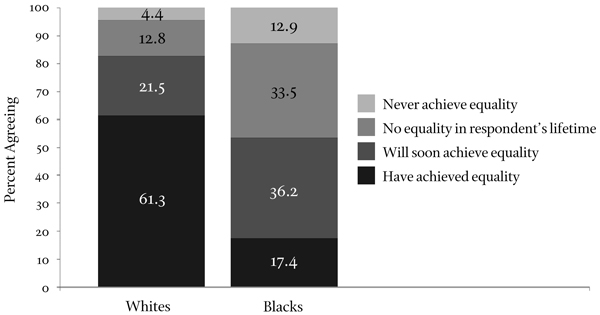
Respondents were asked, “Do you think that blacks have achieved racial equality, will soon achieve racial equality, will not achieve racial equality in your lifetime, or will never achieve racial equality?” Source: Lawrence D. Bobo and Alicia Simmons, Race Cues, Attitudes and Punitiveness Survey (Data Collected by Polimetrix), Department of Sociology, Harvard University, July 2009.
These results underscore why discussions of race so easily and quickly become polarized and fractious along racial lines. The central tendencies of public opinion on these issues, despite real increasing overlap, remain enormously far apart between black and white Americans. When such differences in perception and belief are grounded in, or at least reinforced by, wide economic inequality, persistent residential segregation, largely racially homogeneous family units and close friendship networks, and a popular culture still suffused with negative ideas and images about African Americans, then there should be little surprise that we still find it enormously difficult to have sustained civil discussions about race and racial matters. Despite growing much closer together in recent decades, the gaps in perspective between blacks and whites are still sizable.
The ideas and evidence marshaled in this Dædalus issue should help sharpen our focus and open up productive new lines of discourse and inquiry. Four of the essays directly engage central, but changing, features of racial stratification in the United States. Sociologist Douglas S. Massey provides a trenchant, broad map of change in the status of African Americans. Sociologist William Julius Wilson reviews and assesses his fieldde fining argument about the “declining significance of race.” The core framework is sustained, he maintains, by much subsequent careful research; but Wilson stresses now the special importance of employment in the government sector to the economic well-being of many African Americans. Economist James J. Heckman focuses on education, building the case for enhancing the capacities of families and communities to prepare children to get the most out of schooling. Social psychologist Richard E. Nisbett looks closely at the types of early intervention strategies that evidence suggests are most likely to improve ultimate educational attainment and achievement.
Three essays put the changing status of African Americans in more explicit political, policy-related, and legal perspectives. Political scientist Rogers M. Smith and his colleagues identify the pivotal role played by agents of competing racial policy coalitions, pointing to the differing agendas and degrees of political success and influence of those pursuing a color-blind strategy and those pursuing a color-conscious strategy. Legal scholar Michael J. Klarman challenges the presumption that the U.S. Supreme Court has been a special ally or supporter of African American interests and claims. He suggests that the Court has often, particularly in a string of recent rulings, tilted heavily in the direction of a color-blind set of principles that do little to advance the interests of black communities. Political scientist Daniel Sabbagh traces the impetus for affirmative action and its evolution in the United States and compares that to how affirmative action is now pursued in a number of other countries.
Several essays examine the cultural dynamics of race and racial identities. Anthropologists Marcyliena Morgan and Dionne Bennett examine the remarkable dynamism, worldwide spread, and influence of hip-hop music. Social psychologists Jennifer A. Richeson and Maureen A. Craig examine the psychological dynamics of identity choices facing minority communities and individuals in this era of rapid population change. Political scientist Jennifer L. Hochschild and her colleagues assess how younger cohorts of Americans are bringing different views of race and its importance to politics and social life.
Three essays pivot off the 2008 presidential election. Political scientist Taeku Lee examines the complex role of race, group identity, and immigrant status in forging new political identities, coalitions, and voting behavior. Political scientist Cathy J. Cohen shows the continuing racial consciousness and orientations of black youth. Sociologist Alford A. Young, Jr., examines the special meaning of Obama’s candidacy and success for young black men.
Two final essays push in quite different directions. Sociologist Roger Waldinger argues that even as the black-white divide remains an important problem, we as a nation are facing deep contradictions in how we deal with immigration and immigrants themselves, particularly those coming from Latin America. Historian Martha Biondi muses on continuities with and departures from past traditions in recent discourse surrounding the mission of African American studies programs and departments.
This issue is a companion volume to the Winter 2011 issue of Dædalus, Race in the Age of Obama, guest edited by Gerald Early, the Merle Kling Professor of Modern Letters and Director of the Center for the Humanities at Washington University in St. Louis. It has been my privilege to work with Gerald on this project, and I am grateful to the contributors to this volume for their informed analyses.
This essay’s epigraphs from Martin Luther King, Jr., John Hope Franklin, and Barack Obama, each in its own fashion, remind us of the depth and complexity of race in the United States. Although it is tempting to seek quick and simple assessments of where we have been and where we are going, it is wise, instead, to wrestle with taking stock of all the variegated and nuanced circumstances underlying the black-white divide and its associated phenomena. Just as 1965 seemed a point of inflection, of contradictory lines of development, future generations may look back and regard 2011 as a similarly fraught moment. At the same time that a nation celebrates the historic election of an African American president, the cultural production of demeaning antiblack images – postcards featuring watermelons on the White House lawn prior to the annual Easter egg roll, Obama featured in loincloth and with a bone through his nose in ads denouncing the health care bill, a cartoon showing police officers shooting an out-of-control chimpanzee under the heading “They’ll have to find someone else to write the next stimulus bill” – are ugly reminders of some of the more overtly racialized reactions to the ascendancy of an African American to the presidency of the United States.
As a result of complex and contradictory indicators, no pithy phrase or bold declaration can possibly do justice to the full body of research, evidence, and ideas reviewed here. One optimistic trend is that examinations of the status of blacks have moved to a place of prominence and sophistication in the social sciences that probably was never imagined by founding figures of the tradition, such as W.E.B. Du Bois. That accumulating body of knowledge and theory, including the new contributions herein, deepens our understanding of the experience of race in the United States. The configuration and salience of the color line some fifty or one hundred years from now, however, cannot be forecast with any measure of certainty. Perhaps the strongest general declaration one can make at present is that we stand somewhere between a Jim Crow past and the aspiration of a postracial future.
ENDNOTES
16 Christian E. Weller, Jaryn Fields, and Folayemi Agbede, “The State of Communities of Color in the U.S. Economy” (Washington, D.C.: Center for American Progress, January 21, 2011), http://www.americanprogress.org/issues/2011/01/coc_snapshot.html/print.html (accessed January 23, 2011)
